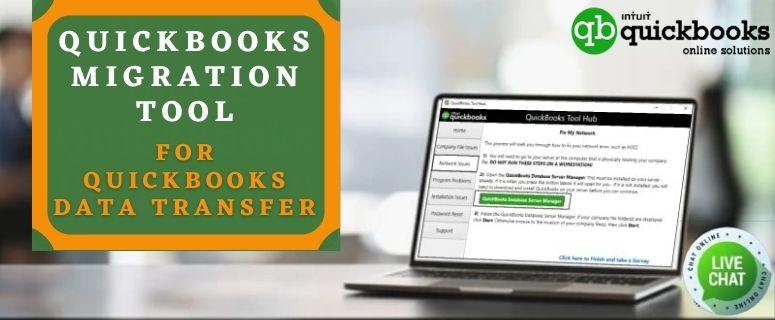As you work on QuickBooks, the company files are bound to grow and your data expands. Regardless of the reason to move QuickBooks to another computer, it’s a complicated process and requires you to perform it manually or with the help of the QuickBooks Migration Tool.
The QuickBooks desktop migration tool eases up the transfer process and saves plenty of time. In this article, we’ll discuss the process of transferring data and applications via the QuickBooks Migrator Tool, its requirements, and an overview of data that can and cannot be copied. Let’s begin.
Requirements for QuickBooks Migration Tool
In order to access the QuickBooks migration tool to transfer QuickBooks from one computer to another, the following requirements must be met.
- Make sure, the new computer has internet access.
- It is necessary to have enough storage space on your USB flash drive, or else, you may encounter issues.
Note: The migrator tool informs you in advance about the required space. It is usually between 150 – 250MB.
How to set up the QuickBooks Migration Tool
Before you perform QuickBooks migration tool download and start transferring the data, the below-listed tips will help you ensure its smooth operation.
- First, ensure the admin rights and set up a secure password. This will allow you to access the copied data on your new computer.
- The Migrator tool uses this password only once. Thus, this password is unique and you should keep it handy for the process.
- Also, while the Migration tool does all the technical work, Flash drive can be used for copying and transferring a few files.
- The Tool downloads QuickBooks Desktop compatible versions automatically on the new computer. Plus, it’ll also integrate it with company files.
Does the Migration Tool transfer all data?
The QB Migration Tool allows you to transfer all the data you need to keep QuickBooks running on the new computer. However, not every piece of data gets transferred. Below is a list of data that gets copied and that doesn’t.
Data that can be transferred
The following data are transferable via QuickBooks desktop migration tool download.
- Recent three company files you accessed on your old computer (Including sample files)
- Memorized and scheduled reports with local attachments
- Details of QuickBooks Desktop including the versions
- QuickBooks letters, custom templates, and forms
- Spell Checker (spell.ini) and (UserDictionary.tlx)
- Finance Statement Designer (FSD data) and (FSD clients)
- Printer Setting (wpr.ini), (PrintEng.ini), and (QBPrint.qbp)
- Advanced reports (QuickBooks Enterprise)
- Statement writer (QuickBooks Accountant)
- Business Planner (.bpw)
- Cash Flow Projector (.cfp)
- Loan Manager (.lmr)
Data that cannot be transferred
Despite being an efficient tool for migrating the data, this tool can’t copy the following data.
- Configuration of Multi-user mode
- Older than three Company Files
- Payment and payroll syncing
- Intuit Data Protect (IDP)
- Backup files
Here’s how to use the QuickBooks Migration Tool
In order to use the migration tool, users need to perform some basic steps on their old and the new computer.
Step 1: Launch your Old Computer
After you launch your old computer, perform the below-listed steps.
- Start with connecting a USB flash drive to the old computer.
- Then, launch QuickBooks desktop.
- Next, visit the “File” menubar and select “Utilities”.
- Also, click “Move QuickBooks to another computer”.
- Then, choose “I’m Ready” and create a unique password.
- Now, comply with the on-screen instructions and choose the USB flash drive
- Finally, wait till all the files are copied.
Step 2: Launch your New Computer
After you finish copying all the crucial files, the next step is to launch your new computer then follow these steps:
- First, plug in your flash drive on the new computer and ensure to not launch the tool automatically.
- Then, visit “This PC” and open the “Flash Drive”.
- Next, double-tap the “Move_QuickBooks.bat” file.
- Now, input the password you created earlier and tap “Let’s go”.
- Once done, wait for the Migration Tool to finish the process.
Note :- (It may take more time depending on the speed of your computer or the internet and your company file size)
- Finally, the migration files on your flash drive will be deleted automatically. However, it is best to rename the QB files on the old computer to prevent using the incorrect file.
Winding Up!
So with this, we come to the end of this article. We believe that after reading this article, it would be much easier for the QuickBooks users to tackle QuickBooks migration tool problems in QuickBooks Desktop. However, if you find this procedure lengthy, time consuming, or if even after following the steps, you are unable to deal with such error, then it would be a better option to get in touch with QuickBooks enterprise support team by dialing our toll-free number i.e. +1 888-704-1357
QuickBooks users might find dealing with these errors a difficult task, but our professionals have much deeper knowledge, which makes it easy for them to handle such issues. Thus, without thinking much, you can simply get in touch with our team of experts and they will clear all your clouds of confusion.


